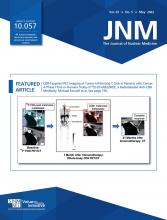REPLY: We thank Dr. Kao for carefully reading our article (1) and for illustrating the value of single–time-point imaging in the practical implementation of patient-specific dosimetry for radiopharmaceutical therapy. We chose to focus on fundamental knowns and unknowns, particularly tumor dose–response relationships, rather than addressing the admittedly challenging logistics of patient-specific dosimetry. As noted in Dr. Kao’s letter, single–time-point formulations exist that may be applied to normal-organ and tumor-absorbed doses, although due to the potentially larger variability in tumor kinetics there may be larger error associated with application to tumor. However, the error in the tumor activity quantification step, depending on tumor size, likely dominates the uncertainty in the dose calculations. Overall, the uncertainty associated with single–time-point methods is unlikely to be clinically impactful. Clinical experience suggests that a severalfold difference in tumor-absorbed dose is needed to overcome the impact of differences in tumor radiosensitivity, dose distribution within the tumor, dose-rate differences, and other biologic effects that impact tumor response to therapy in patients.
Recognizing the imperative of achieving the right balance, we would promote an approach that enables the treating physician—in establishing treatment doses—to consider the multifaceted tradeoffs among absorbed dose accuracy, health economics, the challenges of a busy clinic, and the clinical aspects of the disease. By defining a level of certainty or uncertainty in all calculated absorbed dose values, including those obtained by reduced–time-point or single–time-point methods, the treating physician is provided the information needed to make what is ultimately a clinical decision for a specific patient. If, on the basis of the disease extent and endpoints to be achieved, the physician seeks greater precision in the normal-organ and tumor-absorbed dose estimates, an extended multiple–time-point imaging protocol may be devised in conjunction with the medical physicist.
It is encouraging that in addition to the work described in the letter, the loss of accuracy associated with using a single imaging time point compared with using multiple time points has been recently investigated. Among the ever-growing list of papers in this area, we note the early work on peptide receptor radionuclide therapy by Madsen et al. (2) and Hänscheid et al. (3) and the more recent extension of this approach to other RPTs by Hou et al. (4) and Jackson et al. (5).
We thank Dr. Kao and The Journal of Nuclear Medicine editor-in-chief for giving us the opportunity to address this important topic.
Footnotes
Published online Mar. 10, 2022.
- © 2022 by the Society of Nuclear Medicine and Molecular Imaging.







